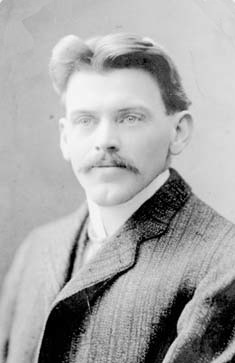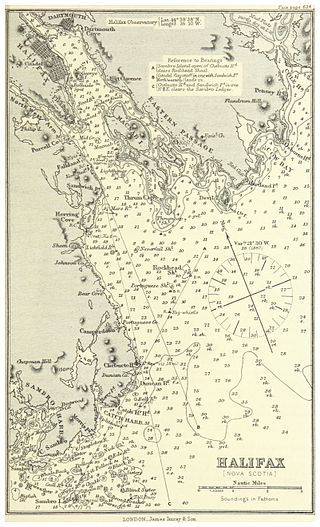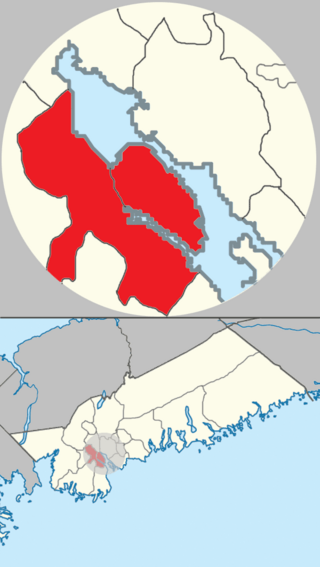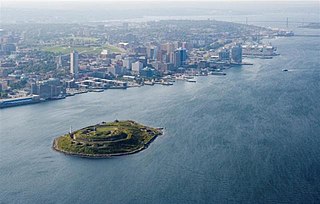Building
By the 1850s a decision was made to consolidate all the Halifax courts under one roof. After fires razed many downtown buildings during that decade (three major fires destroyed many of the city’s wooden buildings between 1857 and 1861, officials abandoned plans for a wooden structure in favour of a more fireproof option made of stone, to protect the legal records it would house. Following the fires, almost all major buildings were constructed of brick and stone. Built on the grounds of what was then the Governor's Garden, location of the court was as contentious back in the 1850s as location of public buildings it is today. Even when the Spring Garden Courthouse was opened the location remained contentious and lawyers, reported to have "complained that the building is too far away from the business parts of the city" and it remained unpopular.
Halifax carpenter Henry Hill designed the building and Toronto-based architect William Thomas and Sons were retained and created a palatial structure in sandstone. The building was built by contractor George Lang who also built The Halifax Club and the Welsford-Parker Monument at the Front gate of St Paul's Cemetery. Made from brown stone from Mary's Point New Brunswick and Wallace sandstone from Cumberland County. The Wallace quarry sandstone was also used at Nova Scotia's Province House, Province House in Charlottetown and some Parliament Buildings in Ottawa. It was proclaimed in the 1860 Halifax city directory that the "court house would do honour to any city in Europe, and cannot be surpassed for architectural beauty by any city of the same size on the continent of America."
The building's architectural exterior is classic with palladian style that represents stability and strength. Decorative features of the building include use of vermiculation and the carving of, replete with carvings of the faces of snarling lions and stern, bearded men in each key stone of the original building's central arches. Interior architectural features to be noted are the pressed metal ceilings, the elaborate arched doorways, the wood paneling and plaster details in the courtrooms and the entry foyer and staircase. In 1863 gas heat replaced 14 fireplaces that inadequately heated the building. The 14 fireplaces remain today though there are none located in the courtrooms. [3]
When originally constructed the Courthouse had two courtrooms, judicial robing and jury rooms, a law library and offices for the prothonotary and registrar of chancery. One of the first occupants was the Sheriff and the office of the Sheriff has remained in the court since. Due to the demand for court space, an addition to the back in the 1881–82 added additional courts. Matching wings were erected on either end of the building in 1908 (west wing designed by Herbert E. Gates, architect) [4] and 1930 (east wing) to offer additional courtrooms and office space that are now occupied by the Provincial Crown and Judges' Chambers.
Today the court houses six courtrooms, judges chambers, court administration offices, the Provincial Crown and cells that can jail up to 50 prisoners. The historic character of the Courthouse remain today and ongoing renovations and upgrades are designed ensure that they honour the original architecture design while at the same time providing efficient modern-day court functions. [5]
The Courthouse has been designated as an historic site of national significance by the Historic Sites and Monument Board.
Halifax Explosion
A collision occurred on December 6, 1917 in Halifax Harbour between the vessels, SS Mont-Blanc and SS Imo and resulted in a blast that decimated the district known as Richmond, in the North End of the city. The courthouse suffered $19,000 in damage even though it was farther to the south. At the time, Nova Scotia Supreme Court cases were heard in court room #2 on the second floor, east side of the stairwell. Courtroom #1 (now #4) was used for everything else including Admiralty Court. [6] The walls of the court room itself had sustained some damage and the blown out windows were boarded up. Purportedly, oil lamps were used because the power was out. [7]
A judicial inquiry known as the Wreck Commissioner's Inquiry was formed to investigate the causes of the collision. Proceedings began at the courthouse on 13 December 1917, presided over by Justice Arthur Drysdale. The inquiry's report of 4 February 1918 blamed Mont-Blanc's captain, Aimé Le Médec, the ship's pilot, Francis Mackey, and Commander F. Evan Wyatt, the Royal Canadian Navy's chief examining officer in charge of the harbour, gates and anti-submarine defences, for causing the collision. All three men were charged with manslaughter and criminal negligence at a preliminary hearing heard by Stipendiary Magistrate Richard A. McLeod, and bound over for trial. However, a Nova Scotia Supreme Court justice, Benjamin Russell found there was no evidence to support these charges. Mackey was discharged on a writ of habeas corpus and the charges dropped. As the captain and pilot had been arrested on the same warrant, the charges against Le Médec were also dismissed. This left only Wyatt to face a grand jury hearing. On 17 April 1918, a jury acquitted him in a trial that lasted less than a day.
Drysdale also oversaw the first civil litigation trial, in which the owners of the two ships sought damages from each other. His decision (27 April 1918) found Mont-Blanc entirely at fault. Subsequent appeals to the Supreme Court of Canada (19 May 1919), and the Judicial Committee of the Privy Council in London (22 March 1920), determined Mont-Blanc and Imo were equally to blame for navigational errors that led to the collision. [13] No party was ever convicted for any crime or otherwise successfully prosecuted for any actions that precipitated the disaster. [14]

On the morning of 6 December 1917 the French cargo ship SS Mont-Blanc collided with the Norwegian vessel SS Imo in the harbour of Halifax, Nova Scotia, Canada. The Mont-Blanc, laden with high explosives, caught fire and exploded, devastating the Richmond district of Halifax. At least 1,782 people were killed, largely in Halifax and Dartmouth, by the blast, debris, fires, or collapsed buildings, and an estimated 9,000 others were injured. The blast was the largest human-made explosion at the time. It released the equivalent energy of roughly 2.9 kilotons of TNT (12 TJ).

Halifax is the capital and most populous municipality of the Canadian province of Nova Scotia, and the most populous municipality in Atlantic Canada. As of 2022, it is estimated that the population of the Halifax CMA was 480,582, with 348,634 people in its urban area. The regional municipality consists of four former municipalities that were amalgamated in 1996: Halifax, Dartmouth, Bedford, and Halifax County.

Patrick Vincent Coleman was a train dispatcher for the Canadian Government Railways who was killed in the Halifax Explosion, but not before he sent a message to an incoming passenger train to stop outside the range of the explosion. Today he is remembered as one of the heroic figures from the disaster.

The North End of Halifax is a neighbourhood of Halifax, Nova Scotia occupying the northern part of Halifax Peninsula immediately north of Downtown Halifax.

Province House in Halifax is where the Nova Scotia legislative assembly, known officially as the Nova Scotia House of Assembly, has met every year since 1819, making it the longest serving legislative building in Canada. The building is Canada's oldest house of government. Standing three storeys tall, the structure is considered one of the finest examples of Palladian architecture in North America.

Halifax Harbour is a large natural harbour on the Atlantic coast of Nova Scotia, Canada, located in the Halifax Regional Municipality. Halifax largely owes its existence to the harbour, being one of the largest and deepest ice-free natural harbours in the world. Before Confederation it was one of the most important commercial ports on the Atlantic seaboard. In 1917, it was the site of the world's largest man-made accidental explosion, when the SS Mont-Blanc blew up in the Halifax Explosion of December 6.

The community of Halifax, Nova Scotia was created on 1 April 1996, when the City of Dartmouth, the City of Halifax, the Town of Bedford, and the County of Halifax amalgamated and formed the Halifax Regional Municipality. The former City of Halifax was dissolved, and transformed into the Community of Halifax within the municipality.

Georges Island is a glacial drumlin and the largest island entirely within the harbour limits of Halifax Harbour located in Nova Scotia's Halifax Regional Municipality. The Island is the location of Fort Charlotte - named after King George's wife Charlotte. Fort Charlotte was built during Father Le Loutre's War, a year after Citadel Hill. The island is now a National Historic Site of Canada. As of August 6, 2020, the island is open to the public on the weekends, from June until Thanksgiving weekend.
Shattered City: The Halifax Explosion is a two-part miniseries produced in 2003 by CBC Television. It presents a fictionalized version of the Halifax Explosion, a 1917 catastrophe that destroyed much of the Canadian city of Halifax. It was directed by Bruce Pittman and written by Keith Ross Leckie. The Film Stars Vincent Walsh, Tamara Hope, Clare Stone, Zachary Bennett, Shauna MacDonald and Ted Dykstra.

Halifax City Hall is the home of municipal government in Halifax, Nova Scotia, Canada. Designed by architect Edward Elliot, and constructed for the City of Halifax between 1887 and 1890, it is one of the oldest and largest public buildings in Nova Scotia. The property was designated a National Historic Site of Canada in 1997.

HMS Niobe was a ship of the Diadem class of protected cruisers in the Royal Navy. She served in the Boer War and was then given to Canada as the second ship of the newly created Naval Service of Canada as HMCS Niobe. The Naval Service of Canada became the Royal Canadian Navy in August 1911. The ship was nearly lost when she went aground off Cape Sable Island, Nova Scotia overnight 30–31 July 1911. Repairs were completed at the end of 1912 and the ship returned to service in late 1914. During the First World War, Niobe patrolled the approaches to the St. Lawrence River and then joined the Royal Navy's 4th Cruiser Squadron to patrol off New York City. The cruiser returned to Halifax, Nova Scotia on 17 July 1915 and never put to sea again. Niobe was paid off in September and served as a depot ship in Halifax. Damaged in the 1917 Halifax Explosion, she was sold for scrap and broken up in the 1920s.

Benjamin Russell was a Canadian lawyer, professor of law, judge, and politician in the province Nova Scotia.

Arthur Drysdale was a lawyer and political figure in Nova Scotia, Canada. He represented Hants County in the Nova Scotia House of Assembly from 1891 to 1907 as a Liberal member.

SSMont-Blanc was a cargo steamship that was built in Middlesbrough, England in 1899 for a French shipping company. On Thursday morning, December 6, 1917, she entered Halifax Harbour in Nova Scotia, Canada laden with a full cargo of highly volatile explosives. As she made her way through the Narrows towards Bedford Basin, she was involved in a collision with Imo, a Norwegian ship. A fire aboard the ship ignited her cargo of wet and dry 2,300 tons of picric acid, 500 tons of TNT, and 10 tons of guncotton. The resultant Halifax Explosion killed approximately 2,000 people and injured about 9,000.

SS Imo was a merchant steamship that was built in 1889 to carry livestock and passengers, and converted in 1912 into a whaling factory ship. She was built as Runic, renamed Tampican in 1895, Imo in 1912 and Guvernøren in 1920.
Stella Maris was a steamship built in 1882 as the Royal Navy gunboat HMS Starling and converted to steam tug in 1905. Stella Maris played a major role in the events of the Halifax Explosion in 1917.
Amherst Internment Camp was an internment camp that existed from 1914 to 1919 in Amherst, Nova Scotia. It was the largest internment camp in Canada during World War I; a maximum of 853 prisoners were housed at one time at the old Malleable Iron foundry on the corner of Hickman and Park Streets. The most famous prisoner at the camp was Leon Trotsky. There was a commemoration of the guards and prisoners for the 100th anniversary of the closing of the Amherst Internment Camp on July 2, 2019, at the Amherst Armoury.

The following outline is provided as an overview of and topical guide to Nova Scotia:

The North Street Station was the railway terminal for Halifax, Nova Scotia from 1877 to 1920. It was built by the Intercolonial Railway in the North End of Halifax and was the second largest railway station in Canada when it opened in 1878. Damaged, but repaired after the Halifax Explosion, it served until the current Halifax terminal location opened as part of the Ocean Terminals project in the city's South End in 1919.

Clement Courtenay Ligoure was a Trinidadian doctor and newspaper publisher who was the first Black physician to practise in Nova Scotia, Canada. He is also noted for treating hundreds of victims of the Halifax Explosion from his home clinic as well as being an editor and publisher of The Atlantic Advocate newspaper.

















